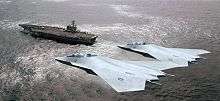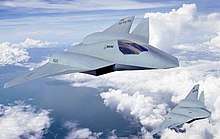F/A-XX Program
F/A-XX is a development and acquisition program for a future sixth-generation air superiority fighter to complement and eventually replace the United States Navy's F/A-18E/F Super Hornet beginning in the late 2020s.[1] A requirement was first identified in June 2008.[2]

Requirements
Air superiority fighter with multi-role capabilities
In April 2012, the Navy issued a formal request for information for the F/A-XX. It calls for an air superiority fighter with multi-role capabilities to initially complement and eventually supersede the F/A-18E/F Super Hornet and EA-18G Growler aircraft in the 2030s, while complementing the F-35C Lightning II and UCLASS unmanned aircraft, that can operate in anti-access/area-denial environments. Primary missions include air combat, air to air, ground attack, surface warfare, and close air support. Platform requirements include super cruise capabilities as well as advanced next generation stealth features, sensors and radars with networking adaptability. Additional missions and capabilities include air-to-air refueling, reconnaissance, surveillance, and target acquisition (RSTA), and electronic warfare electronic attack and countermeasures thereof. Manned, unmanned, and optionally-manned operations for a highly adaptive platform will be part of the new system.[3] The F/A-XX is being pursued as F/A-18 Super Hornets will reach the end of their 9,000 hours of service life by the early 2030s. Aside from the option of buying more F-35Cs, the F/A-XX is seeking to create a new aircraft to replace the Super Hornet's capability and mission set. Just as the F-35C will replace aging F/A-18 Hornets and complement Super Hornets, the F/A-XX will replace aging Super Hornets in the 2030s and complement the F-35C.[4]
Maximum connectivity and sensors
Although the F/A-XX platform will be a sixth-generation fighter aircraft, the Navy is reluctant to talk about a new aircraft because the project is still in the very early stages of development. A range of next-generation technologies may be explored including maximum sensor connectivity, and electronically configured "smart skins." Maximum connectivity refers to massively increased communications and sensor technology, such as having the ability to connect with satellites, other aircraft, and anything providing real-time battlefield information. Smart skins would have sensors and electronics integrated into the fuselage of the aircraft itself to increase sensor performance while reducing drag and increasing speed and maneuverability.[5]
Open architecture
An open architecture design is desired, so different sensors, payloads, and weapons can be plugged in for a specific mission, and be able to be moved around for multiple different missions on different days or different sorties. The resulting open architecture design is likely to take shape depending on which style of new propulsion system is presented by the aircraft industry.
Propulsion
The Navy is working with the U.S. Air Force on a next-generation tactical fighter with super cruise ability, and there is significant disagreement over the Air Force's claims that adaptive-cycle jet engine technology, where the ratios of bypass and compression airflow can be made variable to improve efficiency, can be scaled to benefit a carrier-based fighter.[6][7]
New spectrum of weapons
Chief of Naval Operations Jonathan Greenert speculated in February 2015 that the F/A-XX would not rely primarily on speed or stealth as much as previous generation jet fighters due to better signature detection and proliferating high-speed anti-aircraft weapons. Instead, in addition to its protective features provided by its stealth features, technologies, maneuverability and speed, the fighter is to carry a wide array of new spectrum of advanced weaponry to overwhelm or suppress enemy air defenses and ensure survivabilty and superiority. One approach could create a minimum cost F/A-XX that uses high cost, high performance weapons to defeat threats; according to the Navy's Naval Integrated Fire Control-Counter Air (NIFC-CA) battle network concept, an individual platform would not need to have a full suite of sensors and rely on off-board data-linked information from other platforms to provide targeting information and guide weapons launched from the platform. The F/A-XX platforms will be made to carry missiles, have power and cooling systems for directed-energy weapons, and have sensors that can target small radar cross-section targets; cyber warfare platforms at a tactical level as part of a family of systems are being explored.
Increased payload
The total payload capacity as well as the range and variety of weaponry and equipment of the F/A-XX will at least match or likely rather exceed the current platform i.e. Super Hornet's payload capacity and capabilities.[8]
Unmanned
In May 2015, Secretary of the Navy Ray Mabus stated that the F/A-XX should be a platform with the capability of optional unmanned autonomous operation.[9] The effort may produce a family of systems to replace the capabilities of the F/A-18E/F and EA-18G rather than a single airframe, and the Navy is now conducting an analysis of alternatives for their next-generation aircraft in partnership with the Air Force.[10] Greenert favors an optionally manned aircraft for a modular section that can either hold a pilot or more sensors.
Aircraft carrier compatible
The aircraft must be capable of operating from Navy Nimitz-class and Gerald R. Ford-class aircraft carriers.
Entries

In July 2009, Boeing first publicly unveiled a sixth-generation fighter concept for the F/A-XX program requirement officially revealing its project development. Its renderings and concepts showed a stealth two-seat, twin-engined tailless jet with a blended wing fuselage. Featuring a tandem cockpit, Boeing disclosed that it is intended to be manned or unmanned depending on the mission. The fighter concept is in the 40,000 lb (18,000 kg) weight class. The Northrop Grumman X-47B that was chosen for the UCAS-D program has also been proposed for the F/A-XX effort.[2][11]
Boeing unveiled an updated F/A-XX sixth-generation fighter concept in April 2013. The concept is a tailless twin-engine stealth fighter available in manned and unmanned configurations. It has canards, which usually compromises the frontal radar cross-section, but the lack of a tail shows an emphasis on all-aspect stealth. It also has diverterless supersonic inlets similar to the F-35. The manned version seems to have restricted rearward visibility without the aid of a sensor.[12]
Program timeline
As of 2011, the Department of Defense (DOD) planned to replace older F/A-18C/D Hornets with 220 Lightning IIs. In March of that year, a Navy analysis of alternatives showed that it might buy more F-35C aircraft, develop a new platform, or do both for its NGAD fighter program. In a 31 May 2011 report to Congress, DOD revealed that it was considering buying more F-35C fighters to replace 556 Super Hornets.[13]
On 9 September 2014, the Navy announced that an Analysis of Alternatives (AOA) for the F/A-XX aircraft would begin in 2015. Meetings with industry would be held focusing on building new aircraft to meet the requirement, developing a "family of systems" approach, and discussing mission systems, avionics, and new next-generation weapons systems.
On 4 April 2019, RADM Scott D. Conn, director of Air Warfare in the Office of the Chief of Naval Operations, stated that the Analysis of Alternatives (AoA) for the F/A-XX was to be completed in the spring of 2019, with a final report due in the summer of 2019.[14]
The Analysis of Alternatives for the F/A-XX program was completed in June 2019, and soon after the Navy began the concept development phase of the development process. However, concerns were raised about funding, with Bryan Clark of the Hudson Institute predicting that the program would evolve into a modification of the F-35 or F/A-18 Super Hornet.[15]
References
- Wasserbly, Daniel (12 January 2017). "US Navy hopes for next-generation F/A-XX as soon as late-2020s". janes.com. IHS Markit. Archived from the original on 14 January 2017.
- Trimble, Stephen (7 May 2010), "Boeing plots return to next-generation fighter market", The Dewline, Flight Global
- Majumdar, Dave. "US Navy issues F/A-XX RfI." Flight Global. April 17, 2012.
- "USN, Industry Seek New Concepts For 6th-generation Fighter", Defense news, 10 July 2013.
- "Navy Plans for Fighter to Replace the F/A-18 Hornet in 2030s", Defense tech, 20 November 2014.
- "US Navy already looking beyond carrier-based F-35", Flight global, 9 September 2014.
- Navy Taps Industry in Quest For Next Generation Fighter, USNI, 10 September 2014.
- CNO Greenert: Navy’s Next Fighter Might Not Need Stealth, High Speed, USNI, 4 February 2015.
- Mabus: UCLASS Likely A Bridge to Autonomous Strike Aircraft, F/A-XX ‘Should be Unmanned’, USNI, 13 May 2015.
- Navy Seeking ‘Family of Systems’ to Replace Super Hornets, Growlers; Sheds F/A-XX Title, USNI, 21 April 2016.
- Boeing displays manned F/A-XX concept jet, Flight Global, 9 July 2009
- Boeing unveils updated F/A-XX sixth-gen fighter concept - Flightglobal.com, 8 April 2013
- Lockheed F-35C emerges as candidate for future US Navy contract - Flightglobal.com, 2 June 2011
- Leone, Dario (13 April 2019). "Report on U.S. Navy F/A-XX Next Generation Fighter will be ready in Summer". The Aviation Geek Club. Retrieved 17 October 2019.
- Insinna, Valerie (29 May 2020). "At a budgetary crossroads, the US Navy's aviation wing must choose between old and new". Defense News. Retrieved 22 June 2020.